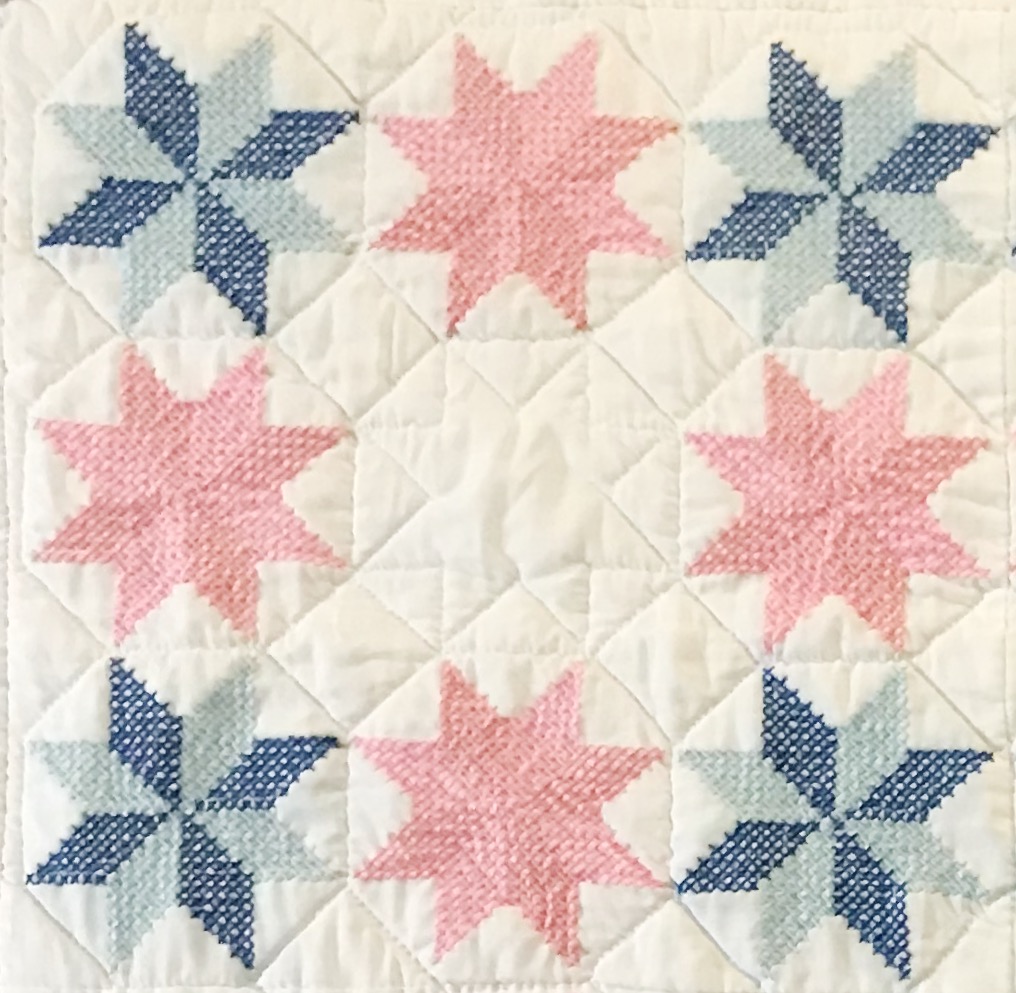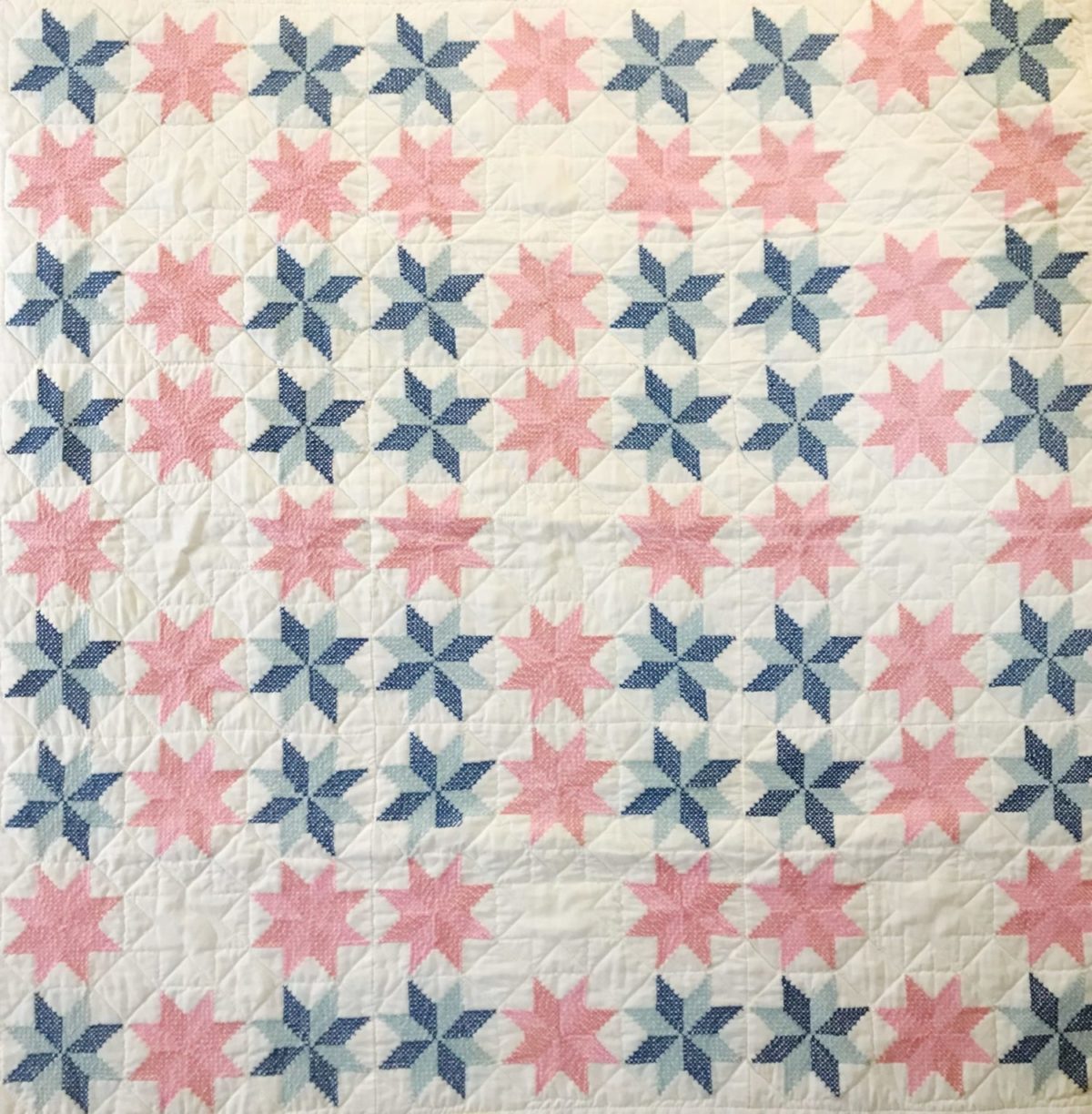Each morning she rose before dawn, pulled on her compression socks, and slipped her blush robe over her nightgown. The floor always creaked as she walked to the kitchen to turn on the coffee pot and fix toast with homemade apple butter. Satiated, and on her second cup of coffee, she moved into the adjacent small, wood-paneled sitting room, big enough only to fit their two chairs and a small television set. With a single lamp lit, she sat in her oatmeal wingback armchair, resting her feet on the embroidered floral wreath of a wooden footstool. As the Earth turned, the Sun greeted her through lace-valanced casement windows. There her rosy fingers, cold from poor circulation, were warmed not by the Sun or the ceramic mug of hot coffee, but by cross-stitching the stars onto a quilt.
He preferred to cross-stitch at dusk after supper. It was good for his arthritis. Even though he had always been an arrogant horse’s ass, old age had humbled him, so he wasn’t too proud to do needlework. The daylight was for running errands around the small town of 2,400, like checking on the family business taken over by his son. But every day before dusk, he returned to their cornflower white house that sat up on a small hill off the mainstreet block. After supper, he put on pajamas, slipped on his robe and poured himself a whiskey neat. He turned on the television and reached for the white stamped quilt in the rattan basket between his forest green La-Z-Boy and her armchair. He was careful to avoid grabbing the middle of the hoop where the threaded needle clung to the magnetic needle minder. He loved to take note of the morning’s progress before picking up where she left off. As sky blue darkened to prussian, he worked on the quilt while television programs ran in the background⏤he really only paid attention on Thursdays when Cheers came on at 9:00. Otherwise, he simply sipped the amber and charted the distillation of the stars as they reappeared.
They chose this pattern for the octagons, inside which two squares fuse into a star. Their umpteen tiny x’s formed blue and pink rhombuses that created octagrams. This was to be a gift for their unborn great grandchild who was yet to be conceived. Each day for months their x’s coalesced into gleaming octagrams. It’s the last thing they would create together in this home.
Of course sometimes the clouds completely covered the sky when it rained or snowed, but this was good for the crops. On those days, they cross-stitched together in the evening, spreading the quilt across both of their laps. They worked slower in order to savor the diffusion of light from their rosy fingers, which transformed their embroidery hoop into the garnet ring that encircles the Earth at the threshold of light and dark. This threshold, a pattern of blues and pinks that simultaneously contained the multitudes of the visible and invisible, was the most sacred gift they could give their great grandchild.
Neither favored blue or pink, for the horizon married the two. They imagined stitching x’s on the axis that united corn fields and sky. At dawn and dusk, sunlight would arrive tangentially, scattering light waves through the transparent atmosphere. For a moment, the cameo blue and sapphire ombré would welcome rhodochrosite layers of bubblegum and rouge splayed across cotton ball clouds.
They knew it was just a matter of time, although they never spoke about it. But at dawn and dusk, each felt the texture of every cross-stitch to reveal the other’s musings. It didn’t feel like death. They thought of the great grandchild who would carry some of their DNA and whose body might be warmed by the scattered light on this quilt⏤a warmth that comforted them, too, as it draped over their legs while their collective x’s grew into octagrams.

The octagon began to feel like a liminal presence. It hinted at a convergence between the square and the circle. The square: a grid that creates the relative horizon, a fleeting orientation. The x’s each created nodes in the shape of a tiny square dispersed across the quilt. The circle: a garnet ring as a threshold between light and dark, a wheel of ruminations on life and death. Could the tiny squares made of x’s, if all layered atop each other to form an octagon, hexadecagon, tricontadigon, and on and on, eventually form a circle? Each node would become much more numerous than seconds on a clock⏤as numerous as the stars in the night sky that the couple had been charting. Time would pass more precisely around this clock, but could the infinite distance between the square and the circle ever come together? Perhaps each diffused stitch constructed the fabric of space and time. She and he both began to wonder about this each time they folded the quilt to place in the rattan basket, when the x’s and octagrams folded into and over each other. Neither ever knew the other’s thoughts.
As they nearly finished charting the stars, the octagram transmogrified into a compass⏤not one with cardinal directions or one for drafting, but one of a univocal sort that would lead by the shape within which the octagram was contained. For what is a compass but a way to be situated with relation to a distant other? A not-yet-conceived great grandchild. An ever-approaching meeting with death.
On another planet, light would not scatter into blues and pinks at the threshold of light and dark. Perhaps red dust clouds would diffuse light like frosted glass, or there would be no transparent atmosphere to scatter light in the first place, preventing the visibility of stars. Any sense of cardinal or celestial direction would be completely upended. But the octagon, a threshold between square and circle, space and time, here and everywhere, would remain a tool for navigation amidst different horizons. Even if the North Star remained, the path toward it would no longer be North.
One summer evening, the elderly couple heard the horizon between earth and sky temporarily disappear. The cumulonimbus clouds transformed the grid into a funnel that pulled the land into the atmosphere. An EF4 tornado destroyed half of the town, including their white house on a hill. The violent, spiraling column of wind stripped the wood paneling completely, and thin needle-like fragments stuck like darts in what remained of walls and furniture. The couple heard the freight train and had just escaped to the basement as it arrived. For a moment, the hyperbolic vacuum hovered over. The home’s square foundation was stretched into a rectangle, completely demolished. Geodesically straight lines appeared to slither like a snake. But the octagrams outlasted the twister. The completed quilt had been stored weeks prior and sat folded in a clear plastic bin, unchanged.
